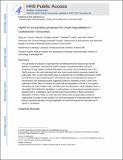ClpAP Is an Auxiliary Protease for DnaA Degradation in Caulobacter Crescentus
Author(s)
Liu, Jing; Francis, Laura I.; Jonas, Kristina; Laub, Michael T; Chien, Peter, 1976-
Downloadnihms819706.pdf (1.196Mb)
OPEN_ACCESS_POLICY
Open Access Policy
Creative Commons Attribution-Noncommercial-Share Alike
Terms of use
Metadata
Show full item recordAbstract
The Clp family of proteases is responsible for controlling both stress responses and normal growth. In Caulobacter crescentus, the ClpXP protease is essential and drives cell cycle progression through adaptor-mediated degradation. By contrast, the physiological role for the ClpAP protease is less well understood with only minor growth defects previously reported for ΔclpA cells. Here, we show that ClpAP plays an important role in controlling chromosome content and cell fitness during extended growth. Cells lacking ClpA accumulate aberrant numbers of chromosomes upon prolonged growth suggesting a defect in replication control. Levels of the replication initiator DnaA are elevated in ΔclpA cells and degradation of DnaA is more rapid in cells lacking the ClpA inhibitor ClpS. Consistent with this observation, ClpAP degrades DnaA in vitro while ClpS inhibits this degradation. In cells lacking Lon, the protease previously shown to degrade DnaA in Caulobacter, ClpA overexpression rescues defects in fitness and restores degradation of DnaA. Finally, we show that cells lacking ClpA are particularly sensitive to inappropriate increases in DnaA activity. Our work demonstrates an unexpected effect of ClpAP in directly regulating replication through degradation of DnaA and expands the functional role of ClpAP in Caulobacter.
Date issued
2016-09Department
Massachusetts Institute of Technology. Department of BiologyJournal
Molecular Microbiology
Publisher
Wiley-Blackwell
Citation
Liu, Jing et al. “ClpAP Is an Auxiliary Protease for DnaA Degradation inCaulobacter Crescentus.” Molecular Microbiology 102, 6 (October 2016): 1075–1085 © 2016 John Wiley & Sons Ltd
Version: Author's final manuscript
ISSN
0950-382X
1365-2958